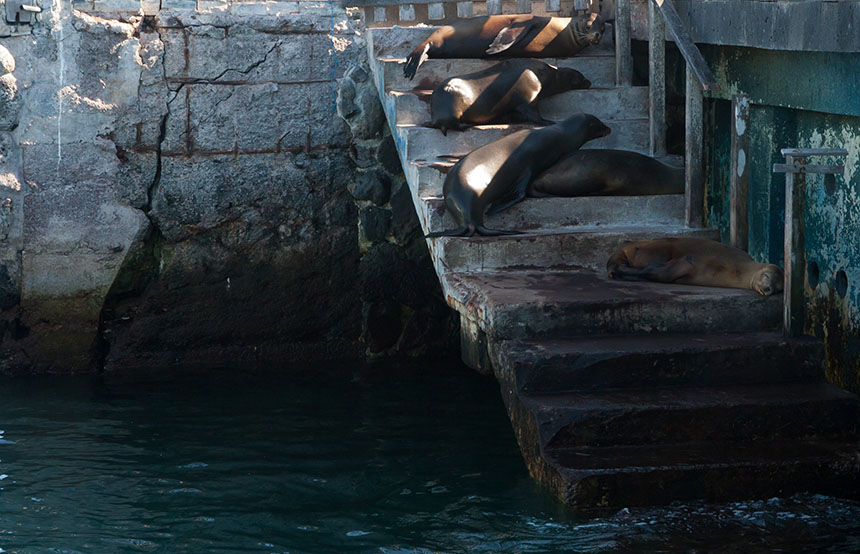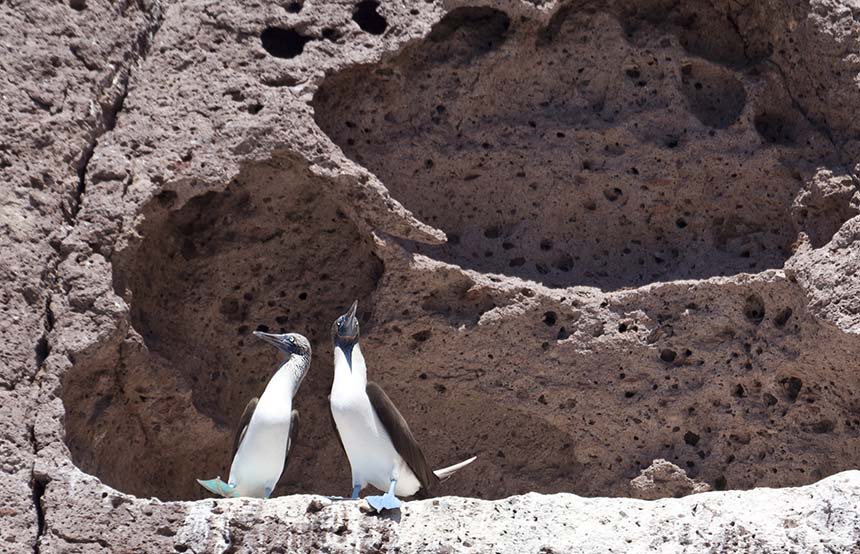Picture this: you’re meandering slowly over bulbous mounds of volcanic rock and past spiney skeletons of half dead trees, all the while keeping your eyes peeled for the distant silhouette of an enormous domed-shell creeping slowly along the horizon. The air is dense with birdsong, plunging you straight into a David Attenborough documentary and leaving you with a sense that wildlife in the Galapagos Islands really is like nothing else in the world. You’re headed for the top of Alcedo Volcano on Isabela Island with its steep sides and postcard-worthy views, when all of a sudden you hear the undergrowth moving, followed by steady crunching sounds and eventually, the patchwork-like carapace and wrinkly neck of one of the most prehistoric beasts in the world comes into view. The Galapagos giant tortoise looks up at you and simply continues its pilgrimage to the verdant grasslands that fill the volcano’s higher grounds. This ecologically naïve wilderness is brimming with wonderfully whacky wildlife, most of which is still much the same as when Charles Darwin first landed there in 1835. The Galapagos Islands are also the only place in the world where saying you want to go on holiday to see boobies is acceptable, the blue-footed kind of course. So, don your boots and grab a pair of binos before looking at some of the most extraordinary wildlife in the Galapagos Islands...
- Galapagos Giant Tortoise
- Galapagos Sea Lion
- Lava Lizards
- Scalloped Hammerhead Shark
- Blue-Footed Booby
- Galapagos Penguin
Galapagos Giant Tortoise
As one of the most famous species on the island and one of the most dinosaur-like creatures on the planet, the Galapagos giant tortoise is an iconic resident of this ancient archipelago. With the word galapágo quite literally translating to tortoise, it hits home just how important these meandering megaliths are to these islands, especially with 13 different species roaming the verdant hillsides. The highlands of Santa Cruz or the volcanic slopes of Alcedo on Isabela island are always guaranteed tortoise watching areas, especially as these gentle giants tend to spend more than half the day snoozing in the shade, so won’t be difficult to spot. As the longest-lived of all land vertebrates, and with the oldest having lived to a grand old age of 175 years old, there is no doubt as to why the giant tortoises ended up on our list of wildlife in the Galapagos Islands.
Galapagos Sea Lion
As the most abundant marine mammal in the archipelago, seeing Galapagos sea lions is a sure-fire way to dive into wildlife in the Galapagos Islands. Watch as their streamlined bodies dart to and fro in the warm waters that surround the archipelago, before they arrive at the beach for an afternoon spent playing or simply enjoying the sun’s rays. They are widespread along the whole coastline and it isn’t hard to spot them, so head out with an expert guide for a tour of the rugged, black rock shore and see how many you can find. You may even catch one taking a nap on a bench on Isabela Island.

Lava Lizards
Lava lizards are more like us sun-seeking travellers than you may think. Other than the obvious differences in appearance, a tail and perhaps scaley skin, these mini iguana look-alikes love baking themselves in the sun’s toasty rays. With seven species on the islands, they are the most prevalent reptiles and although most commonly found on lava, you may walk past a fence or signpost adorned with one of these brightly coloured sun-worshipers.
Scalloped Hammerhead Shark
Seeing a hammerhead shark is on the bucket lists of many and it is unsurprising, given how intriguingly peculiar this iconic marine species is. Their hammer-shaped head, otherwise known as the cephalofoil, is iconic to most, and you can catch a glimpse of them around the northern islands of Darwin and Wolf. The Galapagos Marine Reserve (GMR) is one of the few places on Earth where these incredible creatures gather in their hundreds if not thousands (nobody quite knows why) and also have nurseries for their tiny pups, so if seeing intriguing shark behaviour is up your street, then this is the place to head to. If you’re feeling brave and want to get up close and personal with wildlife in the Galapagos islands, don some dive gear and hop into the water with these slender bronze-bodied beasts.
Blue-Footed Booby
These poor birds have been at the brunt of every other joke thanks to their name (bobo in Spanish means fool or clown) and their comical blue legs, but blue-footed boobies are quite majestic when in the right setting. Although slightly ungainly and a bit awkward on land, in flight they are high-speed divers, much to the disgust of unsuspecting anchovies. Head to the island of North Seymour for the best viewing spots, where the craggy coastline and rocky spurs make for the ultimate booby bolt holes and breeding hotspots. Venture along the shore with an expert guide to see whether you can catch a glimpse of a blue-footed booby doing its famous mating dance.

Galapagos Penguin
You don’t have to go all the way to Antarctica to see penguins. Sitting at around 20 inches tall, the Galapagos penguins are one of the smallest species in the world and due to the lack of soft peat to burrow in on the islands, they call the caves and crevices in the coastal lava home. Isabela and Fernandina islands are the top places to spot these agile birds, but if you fancy living like a penguin, grab a snorkel and hop in the water with them for a swim at Pinnacle Rock on Bartolomé. Wonder at age-old romantics (penguins tend to mate for life) as they tootle around on the volcanic rock, protecting eggs and dark-brown fluffy chicks. Sadly, with only around 2,000 Galapagos penguins left, now is your time to see them, and other at-risk wildlife in the Galapagos Islands.
Although we are ranting and raving about how wonderful the wildlife on the Galapagos Islands is, it would be thoughtless to leave out the fact that four out of six of these incredible creatures are now endangered. So, although we love going on a carefree adventure, it is worth glancing at our Travel Less, Travel Better guidelines to ensure you make the most out of your bucket list trip for you and the wildlife on the Galapagos Islands.
Written by Immy Kelly
